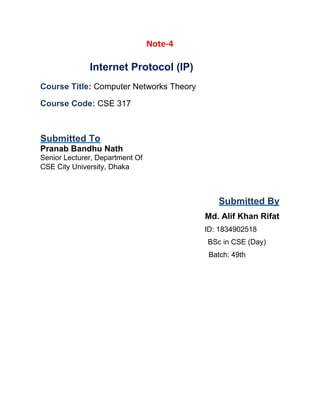
Lesson 4
- 1. Note-4 Internet Protocol (IP) Course Title: Computer Networks Theory Course Code: CSE 317 Submitted To Pranab Bandhu Nath Senior Lecturer, Department Of CSE City University, Dhaka Submitted By Md. Alif Khan Rifat ID: 1834902518 BSc in CSE (Day) Batch: 49th
- 2. Internet Protocol (IP) Internet Protocol (IP), a logical address used to uniquely identify each host on the Internet is called an Internet Protocol or IP address. Each host has a physical address called a MAC address. It determines the company that makes the device. In addition, each host requires a different logical address to connect to the Internet. This logical address is called the IP address. Each host needs an IP address to connect to the Internet. No host or computer can be connected to the Internet without an IP address. Each computer in the network needs an IP address to communicate with the other. Classification of IP addresses: According to the version, the IP address is divided into two parts. • IPv4 (IP version 4) • IPv6 (IP version 6) IP addresses can be further divided into two parts: • Private IP Address • Public IP Address IPv4 IP Version 4: Internet Protocol Version 4 This is a 32-bit IP address. And this IP address is divided into 4 parts and each part has 6 bits. IP addresses are usually expressed in decimal numbers. For example, 192.168.10.10 is an IP address. One we can write and use in binary if we want. However, since there are many numbers in binary, it is difficult to remember, so the IP address is usually expressed in decimals. The IP address of IP version 4 is divided into two parts. The first part is the network part and the last part is the host part. This IP address starts at 0.0.0.0 and ends at 255.255.255.255. It has a total of 4294967296 IP addresses. With which we can identify 4294967294 hosts. According to the class, the IP address is divided into 5 parts. • Class A • Class B • Class C • Class D • Class E Class A:
- 3. We know that IP version 4 is divided into 4 octets and each part has 6 bits. And I also know that each IP address has two parts, the network part, and the host part. The first octet of the Class A IP address is for the network and the last 3 octets are for the host. This means that the first 6 bits are for the network and the last 24 bits are for the host. Class A IP addresses range from 0.0.0.0 to 126.255.255.255. We can use a Class A IP address when we need a large number of hosts on our network. Class B: The Class B IP address starts at 128.0.0.0 and ends at 191.255.255.255. The first 16 bits are used for the network and the last 16 bits are used for the host. We can use the IP address of Class B when we need the same number of networks and hosts in our network. Class C: The Class C IP address starts at 192.0.0.0 and ends at 223.255.255.255. The first 24 bits are used for the network and the last 6 bits are used for the host. We can use Class C IP addresses when we need more networks and fewer hosts. Class D: Class D is a special class IP address. Its range is from 224.0.0.0 to 239.255.255.255. Class D IP address is not open to everyone. The IP address of this network is used for Multicast Group. Class E: The range of IP addresses from 240.0.0.0 to 255.255.255.255 is called Class E. IP addresses of this range are commonly used for biological research. Here the IP address 255.255.255.255 is used for broadcast. Talked about a different class of IP addresses, but didn't talk about one IP address. That address called the loopback address. A loopback address is a special IP address, 127.0.0.1, reserved by InterNIC for use in testing network cards. This IP address corresponds to the software loopback interface of the network card, which does not have hardware associated with it, and does not require a physical connection to a network. The loopback address allows for a reliable method of testing the functionality of an Ethernet card and its drivers and software without a physical network. Private IP Address: Private IP addresses are IP addresses that are not routable, that is, IP addresses that cannot be accessed by the Internet. Each class has some private IP addresses mentioned below.
- 4. Class A from 10.0.0.0 to 10.255.255.255. Class B from 172.16.0.0 to 172.31.255.255. Class C from 192.168.0.0 to 192.168.255.255. Public IP Address: All IP addresses that can be accessed through the Internet are called public IP addresses. All IP addresses except private IPs are called public IPs. IPv6 IP Version 6: Internet Protocol Version 6 is the latest version of the Internet Protocol (IP), a communication protocol that provides an identification and location system for computers on networks and locates traffic across the Internet. The Internet Engineering Task Force (IETF) IPv4 address created IPv6 to address the long- awaited problem. IPv6 made for the purpose of replacing IPv4. In December 1997, IPv6 became a draft for IETF, which later approved it as an Internet Protocol on 14 July 2016. The widely use of mobile phones, notebooks, and wireless devices is increasing the need for new IP addresses day by day. One of the major advantages of IPV6 is the large size of the address. A significant advantage over IPv4's 32-bit address is IPv6's 128-bit address. Provides high-quality services for the internet and online applications like IPv6, IP telephony, video/audio, interactive games, and e- commerce. IPv6 has other advantages besides address space. Such as - Autoconfiguration, Mobility, Extensibility